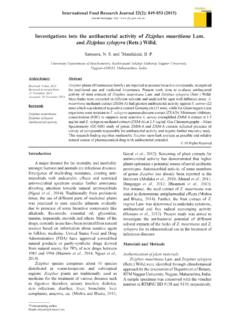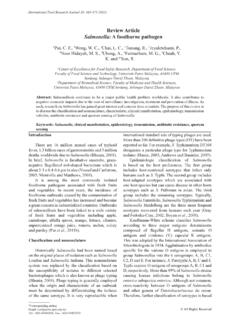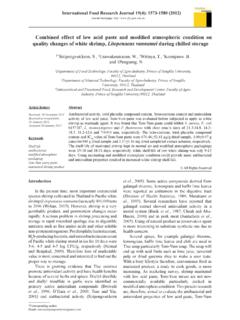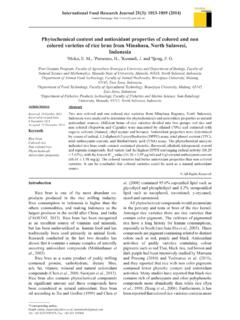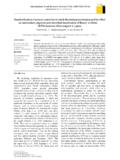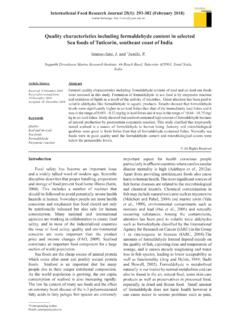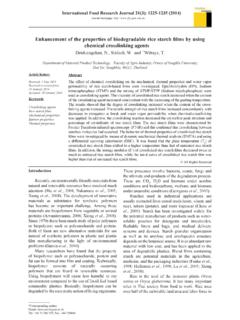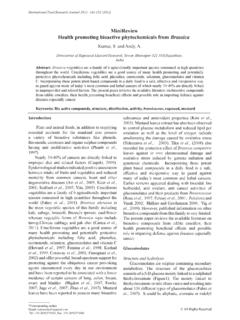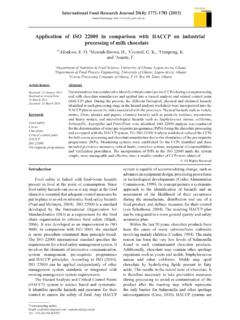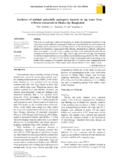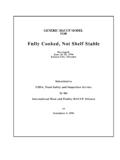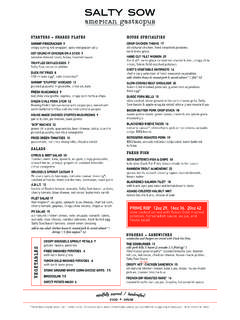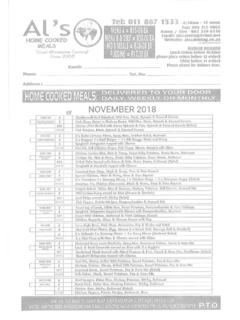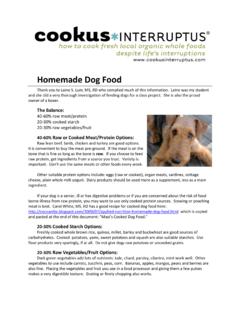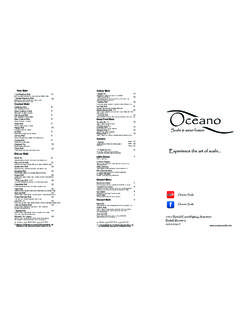Transcription of Fatty acid composition of cooked and fermented beans of ...
1 All Rights Reserved*Corresponding author. Email: International Food Research Journal 19(4): 1401-1407 (2012)Journal homepage: , V. R., 1*Sridhar, K. R. and 2 Chatra, S. K. of Biosciences, Mangalore University, Mangalagangotri, Mangalore 574 199, Karnataka, India 2 Tribology Laboratory, Department of Mechanical Engineering, Indian Institute of Science, Bangalore 560 012, Karnataka, IndiaFatty acid composition of cooked and fermented beans of the wild legumes (Canavalia) of coastal sand dunesAbstractChanges in total lipids and Fatty acid methyl esters (FAMEs) of dry beans of two wild legumes of coastal sand dunes (CSD) (Canavalia cathartica and C.)
2 Maritima) using different treatments ( cooked and cooked + solid-state fermentation with Rhizopus oligosporus) and extraction methods (Soxhlet and cold extraction) were evaluated. Significant variations in total lipids as well as FAMEs were found between beans , treatments and extraction methods. Cold extraction (Bligh and Dyer method) resulted in significantly highest quantity of total lipids in both beans . The polyunsaturated/saturated ratios were in cooked as well as fermented beans . Stearic acid was significantly elevated in fermented beans of both species in Soxhlet and cold extraction, while palmitic acid in both beans was significantly increased only in Soxhlet method.
3 Oleic acid was significantly raised in C. maritima beans on Soxhlet extraction. There is scope for value-addition by following solid-state fermentation of protein-, carbohydrate-, energy-rich and low lipid Canavalia beans using R. oligosporus. Further studies required to evaluate the yield and acceptability of FAMEs in beans of CSD Canavalia spp. to human and or livestock using R. oligosporus at different temperature regimes, incubation periods and amendment of minerals. IntroductionThe goal of food security is perpetual accessibility of adequate, safe and nutritious food by the population to meet the diet and health requirements (FAO, 1996).
4 The risk of food insufficiency and malnutrition continues especially in developing countries due to increased population, scarcity of animal-based foods and shrinking agricultural lands. The legumes (Fabaceae) constitute a major alternative and serve as an important source of proteins and offer economically viable traits (Vietmeyer, 1986; Lewis et al., 2005). Little known underexplored wild legumes (also known as tribal legumes/pulses) will be valuable in nutrition, health and soil fertility (Bressani et al., 1987; Seena et al., 2007). These legumes widen the food as well as environmental security due to their inbuilt traits to withstand the adverse conditions like elevated temperature, drought and soil erosion.
5 A variety of habitats serve as natural repositories of wild legumes deserve serious attempts for germplasm collection, nutritional features and pharmaceutical values (Bhat and Karim, 2009). In the recent past, one of the important habitats received a little attention for exploration of flora is the coastal sand dunes (CSD) (Rao and Sherieff, 2002; Bhat, 2003; Martinez and Psuty, 2004; Maun, 2009). The CSD are dwindling throughout the world due to human interference, pollution, raise in sea level and soil erosion. Among the coastal wild legumes of Southwest coast of India, the indigenous landraces of Canavalia exhibit fast growth, tolerance to coastal environment, disease resistance and gives high seed yield.
6 Some studies on the seeds of coastal sand dune Canavalia revealed their adequacy in protein, fibre, amino acids and Fatty acids (Seena and Sridhar, 2006). Although seeds of Canavalia of CSD are endowed with a few antinutritional components ( concanavalin and canavanine), judicious processing methods help to decrease their concentration to serve as nutraceuticals. Leaves, roots and seeds of CSD Canavalia have traditional uses to cure skin diseases and to promote healing of burns (Chock, 1968; Bhagya and Sridhar, 2009). Roasted C. maritima seed powder substitutes coffee, leaves consists of L-betonicine and roots are useful to treat ciguatera poisoning (Rageau, KeywordsCoastal sand dunes traditional legumesCanavalia catharticaCanavalia maritimaseedsfermentation Fatty acidsArticle historyReceived: 9 March 2012 Received in revised form: 12 April 2012 Accepted:13 April 20121402 Niveditha et 19(4):1401-14071973; Bourdy et al.)
7 , 1992; Bhagya and Sridhar, 2009). Thermally treated seeds of Canavalia showed better Fatty acid profile compared to fresh seeds (Seena and Sridhar, 2006). Solid-state fermentation (SSF) of food stuffs using many microorganisms has been followed to enhance the enzymes, antioxidants, biosurfactants, organic acids and polyunsaturated Fatty acids (Silveira and Badiale-Furlong, 2007; Jang and Yang, 2008). Therefore, the present study aims at evaluating the changes in Fatty acid profile of cooked beans and cooked + SSF beans (Rhizopus oligosporus) of Canavalia species growing on and methodsSeeds and processingCanavalia plants of CSD were identified based on verification of fresh plant materials in using taxonomic descriptions, keys and herbarium (Bhat, 2003).
8 The seed samples of Canavalia cathartica Thouars and Canavalia maritima Thouars were collected from three locations of the CSD of Someshwara, Southwest India (12 47 N, 74 52 E) during summer season (February-March, 2010) as the pods dehisce and dry seeds are available. Healthy seeds without damage were separated from dry pods and sun-dried for two days. Each seed was cut into two halves longitudinally using a nut-cracker to get four pieces of split beans and they were separated from seed coat. Split beans processed with two treatments such as pressure cooking and fungal fermentation.
9 The split beans (25 g) in triplicate were transferred to conical flask (250 ml), soaked in distilled water (1:3 w/v) and pressure- cooked ( L, Deluxe stainless steel; TTK PrestigeTM, Prestige Ltd., India). The cooked split beans were spread on aluminum foil, dried at 40oC in an incubator, milled (Wiley Mill, 30 mesh) and stored in air-tight glass containers. To perform solid substrate fermentation, another set of cooked split beans in triplicates were allowed to attain laboratory temperature, inoculated with two 5 mm plugs of 3-day-old cultures of Rhizopus microsporus var.
10 Oligosporus (MTCC # 556; strain designation # 22959; Institute of Microbial Type Culture Collection, Chandigarh, India) and allowed to ferment for one week at 37oC, later fermented split beans were dried, powdered and stored. Total lipids To follow Soxhlet method of lipid extraction (AOAC, 2003), dry split bean flours (1 g) were packed in thimbles covered with glass wool were extracted with petroleum ether (200 ml) (60-80 C) in a soxhlet extractor. The rate of condensation was fixed to 150 drops min-1, extracted up to 7 hr, cooled, transferred to a pre-weighed beakers and evaporated to dryness at room temperature (28+2 C) for gravimetric estimation of total lipid content.
